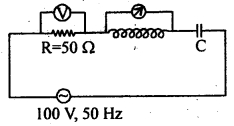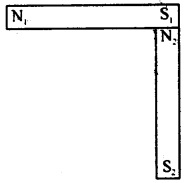CBSE Class 12 Physics – MCQ and Online Tests – Unit 8 – Electromagnetic Waves
Every year CBSE conducts board exams for 12th standard. These exams are very competitive to all the students. So our website provides online tests for all the 12th subjects. These tests are also very effective and useful for those who preparing for competitive exams like NEET, JEE, CA etc. It can boost their preparation level and confidence level by attempting these chapter wise online tests.
These online tests are based on latest CBSE Class 12 syllabus. While attempting these our students can identify the weak lessons and continuously practice those lessons for attaining high marks. It also helps to revise the NCERT textbooks thoroughly.
CBSE Class 12 Physics – MCQ and Online Tests – Unit 8 – Electromagnetic Waves
Question 1.
Maxwell’s equation involving \(\frac{d}{dt}\) \(\vec{B}\) is obtained-from:
(a) Ampere’s law
(b) Gauss’s law
(c) Faraday’s law
(d) Biot-Savart’s law
Answer
Answer: (c) Faraday’s law
Question 2.
Which of the following laws was modified by Maxwell by introducing the displacement current?
(a) Gauss’s law
(b) Ampere’s law
(c) Biot-Savart’s law
(d).None of these
Answer
Answer: (b) Ampere’s law
Question 3.
The dimensional formula of \(\vec{E}\) is:
(a)[MLT-2A-1]
(b) [MLT-3A-1]
(c) [MLT-2A-2]
(d) None of these
Answer
Answer: (b) [MLT-3A-1]
Question 4.
Electromagnetic waves have a speed of
(a) 3 × 105 kms-1
(b)3 × 106 kms-1
(c) 3 × 107 kms-1
(d) 3 × 108 kms-1
Answer
Answer: (a) 3 × 105 kms-1
Question 5.
The dimensions of \(\vec{E}\), \(\vec{dl}\) are identical to that of:
(a) potential
(b) charge
(c) current
(d) None of these
Answer
Answer: (a) potential
Question 6.
Which of the following EMW has highest wavelength?
(a) X-ray
(b) ultraviolet rays
(c) infrared rays
(d) microwaves
Answer
Answer: (c) infrared rays
Question 7.
The dimensional formula of is:
(a) [MLT-2A-1]
(b) [ML0T-2A-1]
(c) [ML0T-3A-1]
(d) None of these
Answer
Answer: (b) [ML0T-2A-1]
Question 8.
Displacement current is always :
(a) equal to conduction current
(b) less than conduction current
(c) greater than conduction current
(d) the sum of current due to flow of positive and negative ions
Answer
Answer: (a) equal to conduction current
Question 9.
Choose the wave relevant to telecommunication :
(a) ultraviolet
(b) infrared
(c) microwave
(d) visible light
Answer
Answer: (c) microwave
Question 10.
EMW are produced by:
(a) charge in uniform motion only
(b) charge at rest only
(c) accelerated or decelerated charge only
(d) all of the above
Answer
Answer: (c) accelerated or decelerated charge only
Question 11.
If \(\vec{B}\) is the magnetic field vector and \(\vec{E}\) is the electric field vector in an em wave, then which of the following relations is correct? Here c is the speed of fight:
(a) c = \(\frac{E}{B}\)
(b) c = BE
(c) c = \(\frac{B}{E}\)
(d) c = \(\frac{1}{EB}\)
Answer
Answer: (a) c = \(\frac{E}{B}\)
Question 12.
The dimensions of E/Bare same as that of:
(a) charge
(b) current
(c) velocity
(d) acceleration
Answer
Answer: (c) velocity
Question 13.
Name the law which states that a varying electric field produces a magnetic field:
(a) Biot-Savart’s law
(b) Faraday’s law
(c) Modified Ampere’s law
(d) None of these
Answer
Answer: (c) Modified Ampere’s law
Question 14.
The existence of EMW was experimentally established by :
(a) Sir S. C. Bose
(b) Maxwell
(c) Marconi
(d) Hertz
Answer
Answer: (a) Sir S. C. Bose
Question 15.
Displacement current is due to:
(a) the flow of electrons
(b) the Varying electric field
(c) the ionization of atmosphere
(d) the flow of protons
Answer
Answer: (b) the Varying electric field
Question 16.
Who first demonstrated the existence of em waves?
(a) Hertz
(b) Maxwell
(c) Ampere
(d) Faraday
Answer
Answer: (a) Hertz
Question 17.
Light Year is the unit of:
(a) distance
(b) time
(c) energy
(d) intensity of light
Answer
Answer: (a) distance
Question 18.
An EMW of v = 3 MHz passes from vacuum into dielectric medium with permittivity Er = 4, then:
(a) Wavelength is doubled and the frequency remains unchanged
(b) Wavelength is doubled and the frequency become half
(c) Wavelength is halved and the frequency remains unchanged
(d) Wavelength and frequency both remain unchanged
Answer
Answer: (c) Wavelength is halved and the frequency remains unchanged
Question 19.
Frequency of a wave is 6 × 1015. Hz. The wave is :
(a) Radiowave
(b) Microwave
(c) X-ray
(d) Ultra violet
Answer
Answer: (d) Ultra violet
Question 20.
If ue and um arc the electric and magnetic field densities in an electromagnetic wave, then (c is the speed of light):
(a) ue = um
(b) ue = c um
(c) ue = \(\frac{u_m}{c}\)
(d) None of these
Answer
Answer: (a) ue = um
Question 21.
Solar radiation is :
(a) transverse EMW
(b) longitudinal EMW
(c) both (a) and (b)
(d) None of these
Answer
Answer: (a) transverse EMW
Question 22.
Choose the wrong statement?
(a) Electromagnetic waves are transverse
(b) Electromagnetic waves travel with the speed of light in free space
(c) Electromagnetic waves are produced by accelerating charges
(d) Electromagnetic waves travel with the same speed in all media
Answer
Answer: (d) Electromagnetic waves travel with the same speed in all media
Question 23.
Which of the following has the dimensions of current?
(a) ε0 \(\vec{E}\).\(\vec{dt}\)
(b) µ0 \(\vec{E}\).\(\vec{dt}\)
(c) \(\frac{\vec{B}.\vec{dl}}{µ_0}\)
(d) \(\frac{\vec{B}.\vec{dl}}{ε_0}\)
Answer
Answer: (c) \(\frac{\vec{B}.\vec{dl}}{µ_0}\)
Question 24.
Which of the following has the dimensions of charge?
(a) \(\frac{ε_0\vec{E}}{\vec{ds}}\)
(b) µ0 \(\vec{E}\).\(\vec{ds}\)
(c) \(\frac{ε_0}{µ_0}\) \(\vec{E}\).\(\vec{ds}\)
(d) \(\frac{µ_0}{ε_0}\) \(\vec{E}\).\(\vec{ds}\)
Answer
Answer: (a) \(\frac{ε_0\vec{E}}{\vec{ds}}\)
Question 25.
Ampere’s circuital law was modified by:
(a) Laplace
(b) Gauss
(c) Maxwell
(d) Hertz
Answer
Answer: (c) Maxwell
















